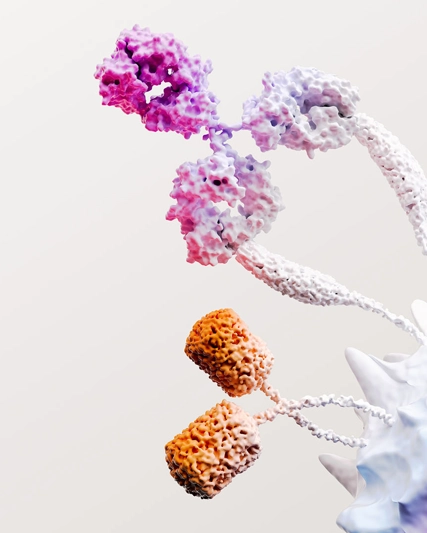Issued: London, UK
For media and investors only
GSK presents data from its advancing liver pipeline at AASLD 2025
- 21 abstracts highlight advances in the treatment of liver conditions, building from GSK’s expertise in inflammation and fibrosis
- Phase II B-Sure study sub-analysis shows durability of functional cure in chronic hepatitis B (CHB) patients treated with bepirovirsen and pegylated interferon (Peg-IFN)
- Late breaking results for once-monthly efimosfermin in metabolic dysfunction-associated steatohepatitis (MASH), supporting the start of phase III clinical trials
- Liver diseases represent one of the leading causes of mortality, accounting for one in 25 deaths worldwide1
GSK plc (LSE/NYSE: GSK) will showcase latest advances in its liver pipeline, with 21 abstracts presented at the American Association for the Study of Liver Diseases (AASLD) The Liver Meeting® 2025, taking place in Washington D.C., from 7 to 11 November, including data from two assets in late-stage clinical development, bepirovirsen and efimosfermin.
Advancing bepirovirsen in chronic hepatitis B and efimosfermin in the treatment of MASH
Bepirovirsen is an antisense oligonucleotide (ASO), which is being evaluated in CHB with the aim of developing a functional cure. Data will be presented from a sub-analysis from the B-Sure phase II study, evaluating the achievement and duration of a functional cure in CHB patients who responded to treatment with bepirovirsen followed by Peg-IFN, a type of immune-boosting therapy.
Efimosfermin is a potential best-in-class once-monthly fibroblast growth factor 21 (FGF21) analog therapeutic for the treatment of MASH, including cirrhosis, and future development in alcohol-related liver disease (ALD). At AASLD, GSK will share a late-breaking oral presentation of the phase II results for efimosfermin in the treatment of MASH, a progressive form of fatty liver disease that involves liver inflammation and damage.
Efimosfermin demonstrated sustained improvement in fibrosis and resolution of MASH in patients with stage F2/F3 disease severity up to 48 weeks. These data supported the start of the ZENITH-1 and ZENITH-2 phase III trials, investigating the efficacy and safety of efimosfermin in patients with moderate and advanced fibrosis due to MASH.
Additional presentations demonstrate GSK’s progress in liver disease, addressing critical unmet needs
Preliminary findings from the GSK ‘990 STARLIGHT study in alcohol-associated liver disease (ALD), show no emerging safety concerns and demonstrate favourable trends in reduced liver enzyme levels despite ongoing alcohol consumption, that may correspond to improvements in hepatocyte ballooning, a significant indicator of liver injury.
Data supporting linerixibat's mechanism of action and safety profile in cholestatic pruritus, following the recent publication of the phase 3 GLISTEN study in Lancet Gastroenterology & Hepatology. 2 Cholestatic pruritus is one of the most common symptoms of primary biliary cholangitis, an autoimmune disease that can lead to liver failure.
GSK’s approach to liver disease is based on a deep understanding of fibrosis and inflammation to develop interventions that stop and reverse disease progression. Liver disease remains one of the leading causes of mortality and is accountable for one in 25 deaths worldwide.
Full list of GSK presentations at AASLD 2025:
| Abstract Name | Presenter | Presentation Details |
|---|---|---|
| Bepirovirsen | ||
| Up to 12 months’ durability of functional cure with bepirovirsen plus Peg-IFN sequential therapy in B-Together responders: B-Sure study | Carla S. Coffin | Poster presentation #1210 |
| Intrahepatic immunophenotyping of participants with chronic hepatitis B receiving bepirovirsen in the B-Fine study reveals diverse changes in immunological status | Adam Gehring | Poster presentation #1214 |
| Intrahepatic and peripheral immunophenotyping of participants with chronic hepatitis B receiving bepirovirsen in the B-Fine study strongly suggests that bepirovirsen may trigger a humoral response | Andre Boonstra | Poster presentation #1215 |
| Retrospective analysis of B-Clear study HBsAg levels with the ultrasensitive Lumipulse HBsAg iTACT assay and association with response and relapse | Scott Speer | Poster presentation #1308 |
| Proteomic profiling in prefilled syringe study demonstrates bepirovirsen’s immune stimulatory effect | Jenn Singh | Poster presentation #1139 Poster of Distinction |
| Risk factors and consequences of pre- and on-treatment alanine aminotransferase (ALT) flares in patients with chronic hepatitis B virus (cHBV) infection: a United States (US) cohort study | Myriam Drysdale | Poster presentation #1277 |
| Characteristics and healthcare resource utilization for patients experiencing hepatitis B surface antigen loss in patients living with chronic hepatitis B virus in the United States | Myriam Drysdale | Poster presentation #1176 |
| Economic Burden of Non-Cirrhotic Patients with Chronic Hepatitis B Virus Infection in the United States | Anna D Coutinho | Poster presentation #1290 |
| Characteristics and Healthcare Resource Use of Patients Receiving Care for Chronic Hepatitis B Virus Infection in the US: A Cross-sectional Survey | Anna D Coutinho | Poster presentation #1260 |
| A modified nominal group technique consensus to define implementation priorities for a chronic hepatitis B functional cure treatment pathway | Carla S. Coffin | Poster presentation #3114 |
| Efimosfermin | ||
| Once-monthly Efimosfermin Alfa for Up to 48 Weeks in Metabolic Dysfunction-Associated Steatohepatitis with F2/F3 Fibrosis: Results from a Phase 2, Open-Label Extension Study | Mazen Noureddin | Oral presentation #5011 |
| GSK ‘990 | ||
| HSD17B13 expression is increased in ballooned hepatocytes from patients with steatotic liver disease (SLD) and can be therapeutically targeted by GSK4532990 in patients with alcohol-associated liver disease (ALD) | Nikhil Vergis | Poster presentation #1495 Poster of Distinction |
| GSK4532990 pharmacokinetic–pharmacodynamic (PK–PD) modelling supports quarterly and monthly siRNA dosing for MASH in the HORIZON phase 2b study | Brandon Swift | Poster presentation #4099 |
| Serum Multiomics Predicts Liver Histopathology and Disease Prognosis in Metabolic Dysfunction-Associated Steatohepatitis (MASH) | Mark Harpel | Poster presentation #2055 |
| Linerixibat | ||
| Establishing the safety profile of linerixibat for the treatment of cholestatic pruritus in primary biliary cholangitis: Pooled safety analysis of GLIMMER and GLISTEN studies | Gideon M. Hirschfield | Poster presentation #4402 Poster of Distinction |
| Treating itch in primary biliary cholangitis – what is a clinically meaningful change in the Worst Itch Numerical Rating Scale? | Brooke M. Currie | Poster presentation #4452 |
| A quantitative systems pharmacology (QSP) model to interrogate the underlying mechanisms of cholestatic pruritus (itch) in primary biliary cholangitis (PBC) and the impact of linerixibat treatment | Brandon Swift | Poster presentation #4436 |
| Reduction in IL-31 with linerixibat is associated with pruritus response in patients with PBC and cholestatic pruritus | Christopher Bowlus | Poster presentation #4393 Poster of Distinction |
| Longitudinal description of liver biochemistry among patients with primary biliary cholangitis in the United States | Kaitlin Hagan | Poster presentation #4527 |
| Rate of liver events and related complications in a prevalent primary biliary cholangitis population: A US claims database analysis | Kaitlin Hagan | Poster presentation #4508 |
| Impact of linerixibat on pharmacodynamic biomarkers and mediators of cholestatic pruritus in primary biliary cholangitis (PBC) in the Phase 3 GLISTEN study | Andreas E. Kremer | Oral presentation #0214 |
About GSK research in hepatology
GSK is extending its expertise in inflammation to develop a next wave of innovation for the millions of people affected by chronic and life-threatening fibro-inflammatory liver conditions. GSK has a growing hepatology pipeline, harnessed by the science of the immune system and advanced technologies, with potential therapies for chronic hepatitis B, primary biliary cholangitis (PBC) and advanced steatotic liver disease (SLD), including metabolic dysfunction-associated steatohepatitis (MASH) and alcohol-associated liver disease (ALD).
About GSK
GSK is a global biopharma company with a purpose to unite science, technology, and talent to get ahead of disease together. Find out more at gsk.com.
Cautionary statement regarding forward-looking statements
GSK cautions investors that any forward-looking statements or projections made by GSK, including those made in this announcement, are subject to risks and uncertainties that may cause actual results to differ materially from those projected. Such factors include, but are not limited to, those described in the “Risk Factors” section in GSK’s Annual Report on Form 20-F for 2024, and GSK’s Q3 Results for 2025.
References
- Devarbhavi H, et al. J Hepatol. 2023;79(2):516–537.
- Hirschfield GM, et al. Linerixibat in Patients with Primary Biliary Cholangitis and Cholestatic Pruritus (GLISTEN): A Randomised, Multicentre, Double-Blind, Placebo-Controlled, Phase 3 Trial. Lancet Gastroenterol Hepatol. ePub Ahead of Print. doi.org/10.1016/S2468-1253(25)00192-X


